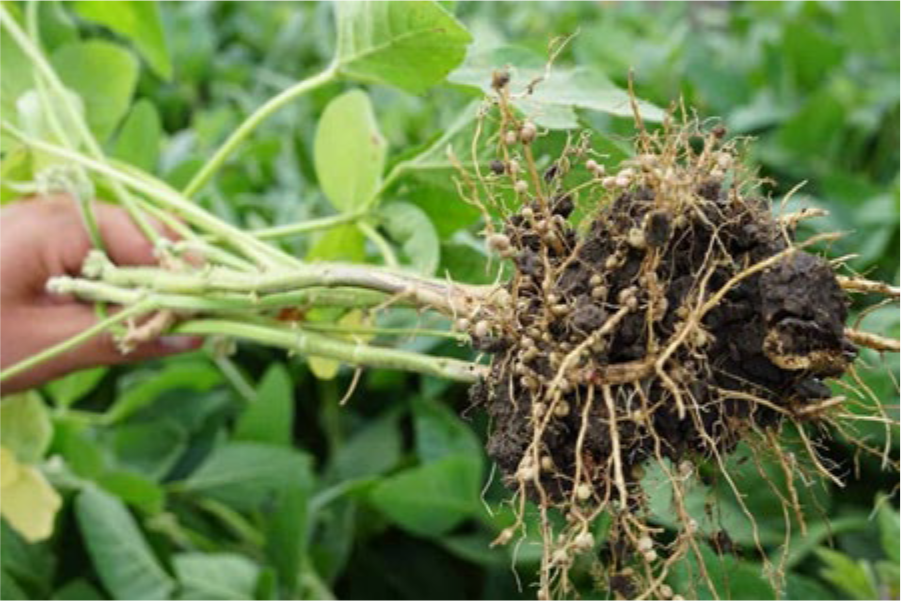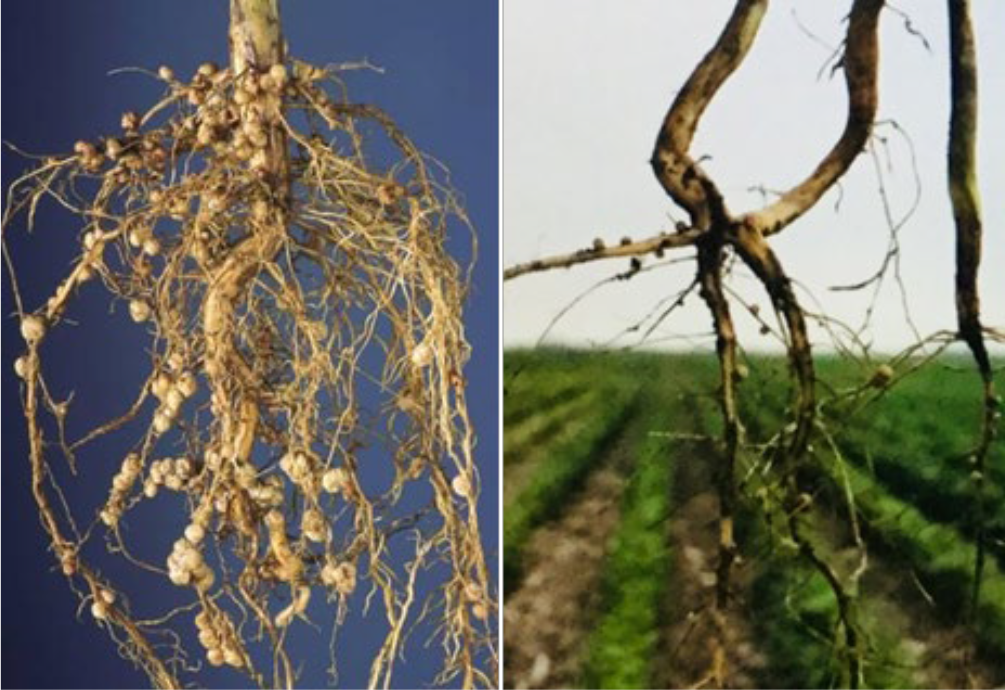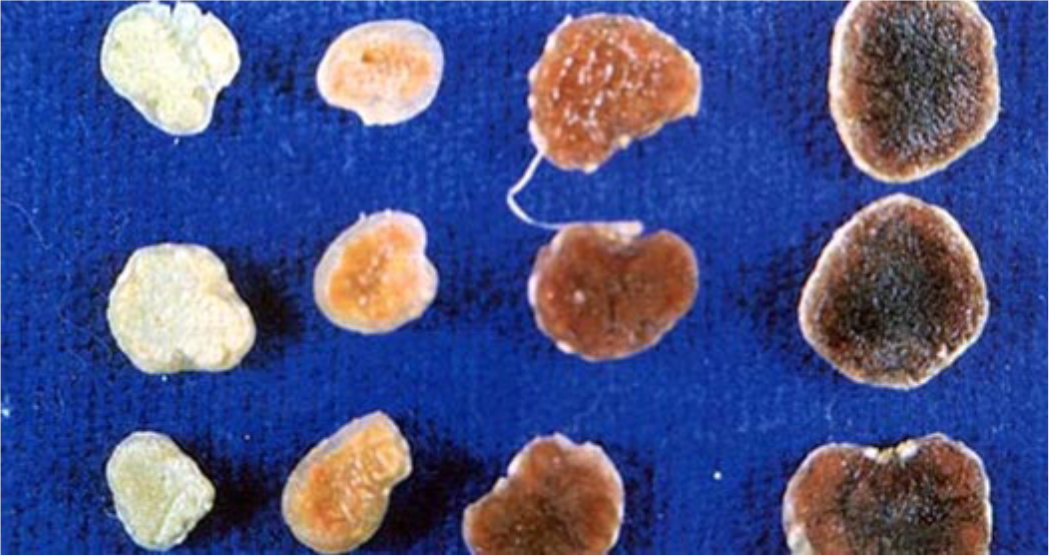⇦ Back to Soil Fertility and Plant Nutrition Home
¶ Introduction
Properly inoculated legumes have the capability to furnish significant amounts of nitrogen to a grain crop that follows in the rotation. The available nitrogen that can be credited depends on crop condition, soil characteristics, and seasonal factors.
This Crop File discusses the nitrogen replacement and crop rotation effects of soybeans in a crop rotation with corn and other crops. (Also see Crop File 1.02.011, Legume Crops and Nitrogen.)
¶ A. Biological nitrogen fixation
- Requires symbiotic relationship (partnership) between soybean roots and soil bacteria.
- Legume roots provide food source (energy) for bacterial metabolism.
- Rhizobia bacteria colonize roots and provide nitrogen.
- Bacterial activity converts non-available atmospheric nitrogen (N2) into plant-available ammoniumnitrogen (NH3-N)
- Ammonium-nitrogen then used by plant to metabolize protein compounds
- Soybeans require about 5 lb. nitrogen uptake per bushel of yield.
- Legumes use residual soil nitrogen first.
- When residual nitrogen is depleted, biological fixation begins if effective nodules are present.
- Host plant expends less energy when utilizing residual soil nitrogen than when nitrogen is obtained from biological fixation.
¶ B. Nodulation Process
- Success depends on quality and quantity of bacteria population.
- Rhizobia can survive for many years in soil.
- Inoculating soybean seeds puts bacterial population directly onto seed.
- Direct contact helps increase opportunity for maximum nodulation and nitrogen fixation.
- Nodulation typically starts during V2 to V3 growth stage.
- Second or third fully developed trifoliate.
- Maximum nodulation at R3 to R5 growth stage.
- Beginning pod to beginning seed stages
¶ C. Effective Nodulation
- Symbiotic fixation process requires:
- atmospheric nitrogen (N2),
- adenosine triphosphate (ATP) for energy, and nitrogenase enzyme
- Leghemoglobin appears in center of nodule at onset of fixation
- Is pigmented compound that imparts reddish color to nodule
- Is oxygen carrier, similar to human blood hemoglobin
¶ Figure 1. Nodules developed on roots of soybean plants. (www.legumehub.eu)

¶ Figure 2. Well nodulated root system (left); poorly nodulated (right)

¶ D. Nodulation Problems
- If field conditions limit colonization and limit nodulation, soil must supply entire nitrogen requirement.
- Field conditions favoring poor nodulation:
- Not cropped to soybeans for several years.
- Natural Rhizobia population could be reduced.
- Field has high levels of residual soil nitrogen.
- Manure or wastewater has been applied
- When soybeans followed other legumes in rotation
- With high levels of carryover nitrate from fertilizer
- Flooded or chronically wet areas.
- Can create oxygen-deprived soil environment.
- Limits survival of Rhizobia bacteria.
- Acidic soil; pH below 5.6.
- Rhizobia bacteria are sensitive to acid soil
- Can affect population and longevity
- Sandy and/or low organic matter soils
- Poor microbial environment
- Can affect Rhizobia population and longevity.
- Cool soil temperatures
- Limits microbial activity
- Not cropped to soybeans for several years.
¶ E. Evaluating Nodulation
- Dig up 10 to 15 plants in each area (good areas and bad areas)
- First evidence of nodules can be found about one week after planting
- Nodulation begins at V2 to V3 stage
- Determine number of nodules per plant
- Early in the season: should have 5 to 8 per plant
- Later in season: should have 8 to 20 per plant
- Nodule location on root system
- if located near tap root, are from recent inoculation
- If located on lateral roots are, from natural field population
- Identify number of effective (active) nodules
- Split nodule and observe inside color
- White color: nodule not actively working to fix nitrogen
- Can be considered “parasitic”
- Bacteria receiving energy, but not providing ammonia-nitrogen to plant
- May or may not become effective at later date
- Pink color: effective nodule, actively working to fix nitrogen
- Pink to reddish color due to presence of hemoglobin
- Brown color: nodule no longer working to fix nitrogen
- Nodule is old or stressed
- Color due to breakdown of leghemoglobin
¶ Figure 3. Nodules Sliced in Half

¶ F. Soybean nitrogen “credit”
- Nitrogen “credit”: Difference in nitrogen fertilizer requirement between rotations where corn follows corn compared to corn-soybean rotation
- “Credit” is considered to be amount of nitrogen potentially replaced by previous soybean crop
- Only applicable when corn or grain sorghum immediately follows soybeans in rotation
- Credit does not extend to second-year corn or sorghum
- Typical assumption: subtract one pound of nitrogen for each bushel of soybean yield produced
- Actual nitrogen credit can vary year-to-year and location-to-location
- Table 1 shows typical nitrogen replacement values recommended by various state universities for state and regions
- Economically optimal nitrogen replacement rate identified by research is typically higher than recommended credit
- Lower rate is recommended to minimize risk from applying deficient nitrogen fertilizer rate
- Nitrogen replacement effect only partially due to nodulation or residue decomposition
- Nitrogen harvested in soybean grain often equals or exceeds nitrogen inputs from fixation
- Roughly 50% of total nitrogen requirement for soybean yield comes from symbiotic fixation
- Can range from 35% to 75% of requirement
- Residual soil nitrate may be depleted significantly by soybean crop if nodulation is ineffective
- Possible non-nitrogen rotation effects
- Relative amount of above-ground biomass
- Soybean crop has less residue and less surface cover than corn or sorghum
- Soil warms up earlier following soybeans
- Microbial activity and residue decomposition begins sooner, releasing nitrogen sooner
- Carbon-to-nitrogen ratio (C:N) of soybean residue ranges from 20:1 to 40:1
- Corn residue C:N ratio: 60:1
- Soybean residue more easily decomposed
- Less potential for short-term nitrogen immobilization
- Pest life cycles can be interrupted by soybeans in rotation
- Possible improvement in corn root functions during season following soybeans
- Could be due to soybean root exudates or changes in mycorrhizal fungi communities
- May be potential improvements in soil physical properties, moisture availability following soybeans
- Relative amount of above-ground biomass
¶ G. Nitrogen Credit Adjustments
- Credits can be underestimated in dry years when yields are low
- Early season drought stress (before blooming)
- Nodulation and nitrogen fixation will likely be poor
- Nitrogen credit should be reduced or discounted
- Late-season drought stress (during or after podding)
- Much of the nitrogen has already been fixed by this time
- Use credit close to “normal”
- Early season drought stress (before blooming)
- No nitrogen credit for small grains that follow immediately in crop rotation
- Nitrogen in residue does not normally have enough time to convert to available forms before it is needed by the small grain crop
¶ Table 1. Nitrogen “Credit” for Corn Following Soybeans |
|
|---|---|
| State, Region with State | Nitrogen Replacement Value (lbs N/acre) |
| Arkansas | n/a |
| Illinois* | |
| North | 27 |
| Central | 19 |
| South | 0 |
| Lake Springfield Watershed | 45 |
| Indiana* | |
| Central | 27 |
| NE/EC | 29 |
| NC/NW/WC/SW/SC/SE | 26 |
| Sandy, non-irrigated | 26 |
| Iowa* | |
| Main | 43 |
| Southeast Iowa | 55 |
| Kansas, all | 40 |
| Michigan* | |
| High/very high productivity | 25 |
| Medium/low productivity | 25 |
| Loamy sands/sands (CEC < 8) | 0 |
| Minnesota*, all | 31 |
| Missouri, all | 30 |
| Nebraska | |
| Soybean yields ≥ 30 bu/ac | |
| Medium/fine textured soils | 45 |
| Sandy soils | 25 |
| Soybean yields < 30 bu/ac | 1 lb N/bu soy yield |
| Ohio*, all | 16 |
| Oklahoma | n/a |
| Ontario, all | 27 |
| Pennsylvania | 1 lb N/bu soy yield |
| South Dakota | 40 |
| Texas | n/a |
| Wisconsin* | |
| High/very high yield potential | 41 |
| Medium/low yield potential | 18 |
| Irrigated sands | 0 |
| Non-irrigated sands | 0 |
| Virginia, all | 0.5 lb N/bu soy yield |
| * MRTN, corn price:fertilizer ratio = 10:1 http://cnrc.agron.iastate.edu/nRate.aspx |
|
¶ References
Agronomy Fact Sheet Series #30. Cornell Univ. Coop. Ext., Ithaca NY. 2 pg.
Camberato, J., et. al. 2022. Nitrogen Management Guidelines for Corn in Indiana. Purdue Univ. Dept. of Agronomy. West Lafayette, IN. 8 pg. accessed 07Jun2022. agry.purdue.edu/ext/corn/news/timeless/nitrogenmgmt.pdf
Iowa State Univ. Agronomy Ext. 2022. MRTN calculator. accessed 07Jun2022. http://cnrc.agron.iastate.edu/nRate.aspx
Leikam, D., et. al. 2007. Using legumes in crop rotation. Bull. L-778, Kansas State Univ. Coop. Ext., Manhattan, KS. 4 pg.
Mark David, M. and F. Below. 2003. U of I Study Reaffirms Significance of the Soybean Nitrogen Credit. ACES News, Febr. 1, 2003. Univ. of Illinois Urbana-Champaign. accessed 02Nov2018.http://www.aces.uiuc.edu/news/special-issues/springfarm/Nitrogen.htm
Sawyer, J. 2018. CROP 3073: Nitrogen Use in Iowa Corn Production. Iowa State Univ. Coop Ext. Ames, IA. 10 pg.
Steinacher, T. 2018. Soybean Nodules and Nitrogen Demand. ILSoy Advisor. Illinois Soybean Association’ Bloomington, IL. accessed 06Jun2022. https://www.ilsoyadvisor.com/soybean-nodules-and-nitrogen-demand/
Zoubek, G. and A. Nygren. 2008. Giving Proper Nitrogen Credit for Legumes in Corn and Milo Rotations. Crop Watch, 10/21/2008. Univ. of Nebraska Coop. Ext. Svc., Lincoln NE. accessed 20May2022. https://cropwatch.unl.edu/giving-proper-nitrogen-credit-legumes-corn-and-milo-rotations